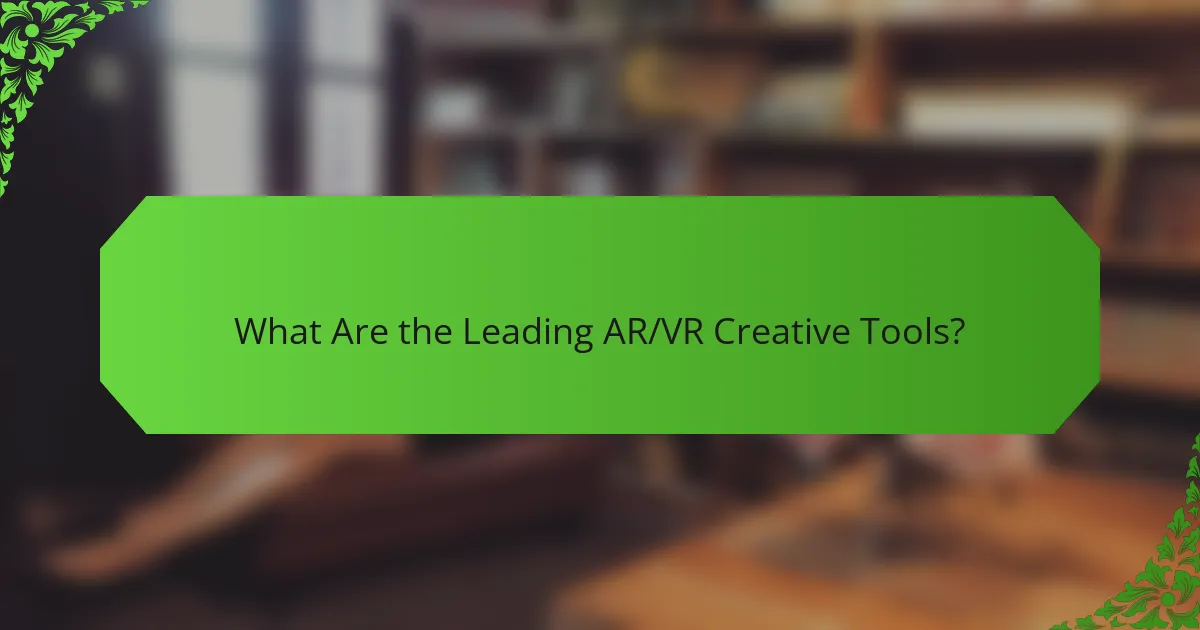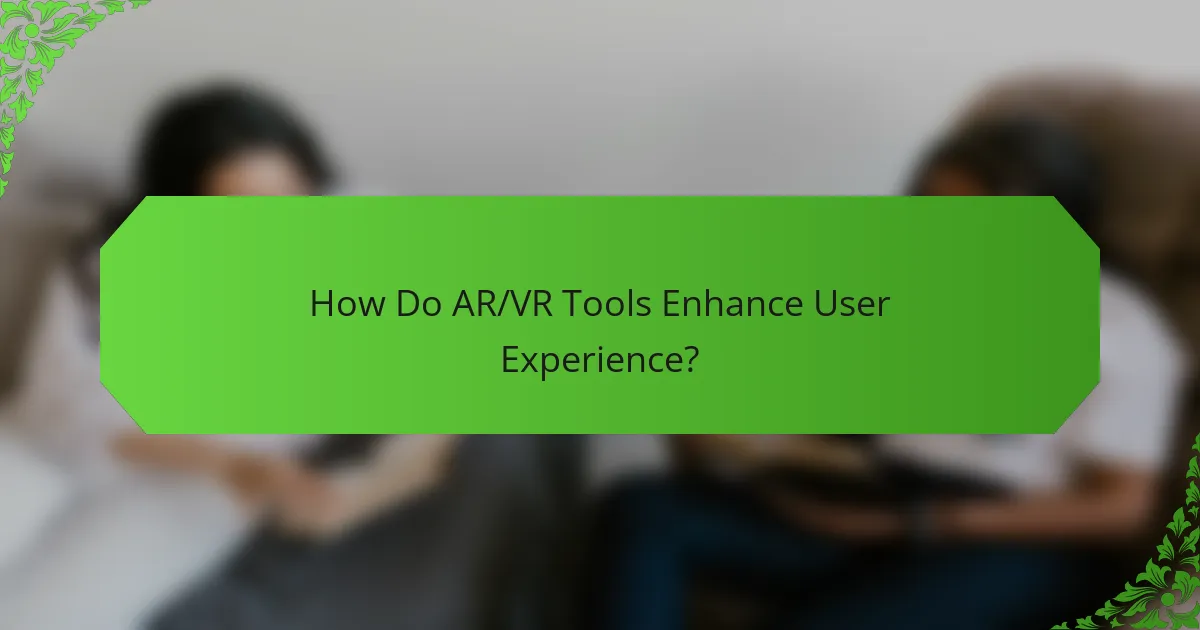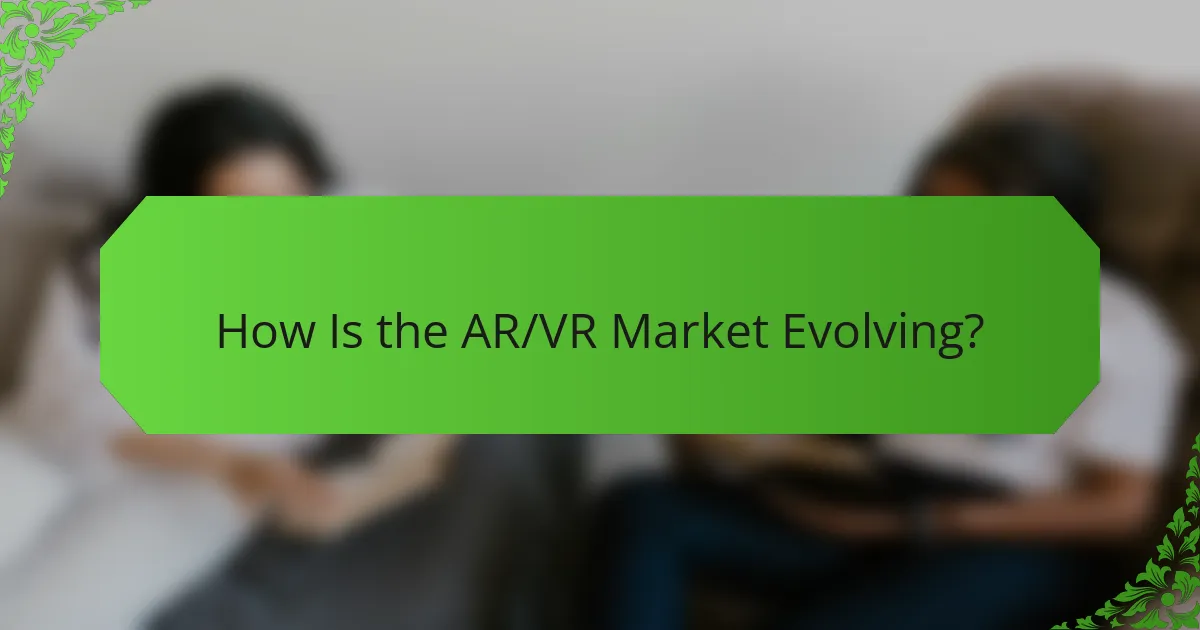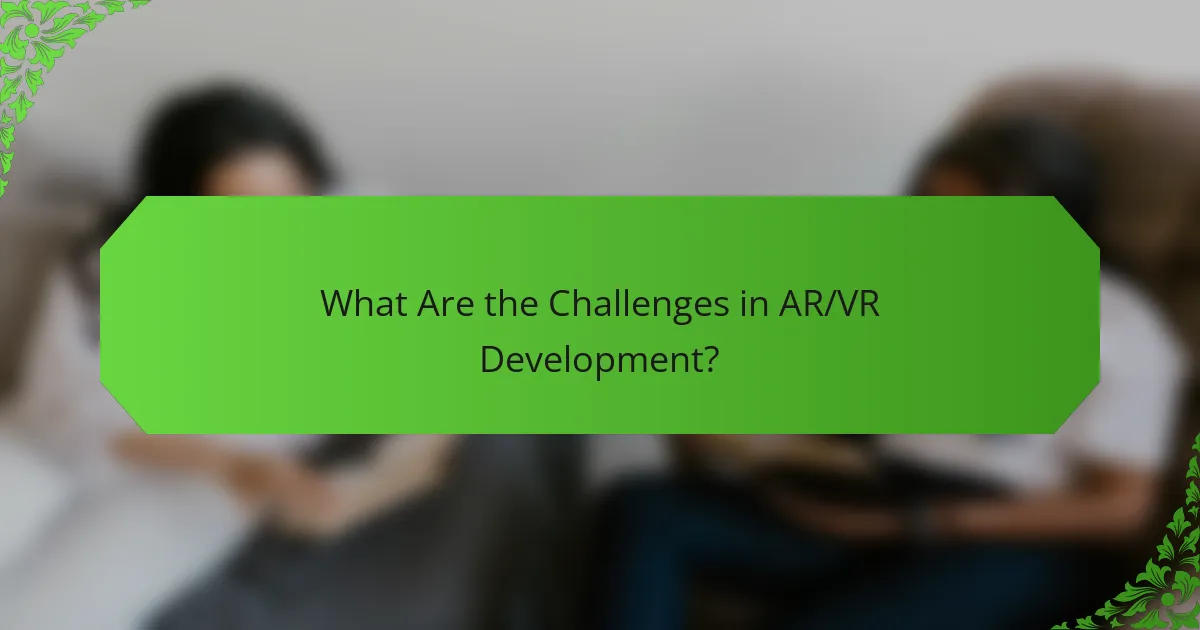Augmented Reality (AR) and Virtual Reality (VR) creative tools are essential software platforms that empower developers and designers to craft immersive experiences tailored to various industries. By enhancing user experience through engaging and interactive environments, these technologies facilitate more intuitive interactions with digital content. As AR and VR continue to evolve, they are revolutionizing sectors such as training, visualization, entertainment, and retail, driving greater engagement and efficiency.

What Are the Key AR/VR Creative Tools?
The key AR/VR creative tools are software platforms that enable developers and designers to create immersive experiences. These tools vary in functionality, ease of use, and application, catering to different aspects of augmented and virtual reality development.
Unity
Unity is a leading platform for AR and VR development, known for its user-friendly interface and extensive asset store. It supports a wide range of devices and offers robust features for 3D modeling, animation, and scripting.
When using Unity, developers can leverage its cross-platform capabilities to deploy applications on various devices, including smartphones and VR headsets. The integration of C# scripting allows for flexibility in creating interactive experiences.
Unreal Engine
Unreal Engine is renowned for its high-fidelity graphics and powerful rendering capabilities, making it ideal for creating visually stunning AR and VR applications. It utilizes a node-based scripting system called Blueprints, which simplifies the development process.
This engine is particularly favored in the gaming industry but is increasingly used in architecture and film for virtual production. Its real-time rendering capabilities allow for immediate feedback during the design process, enhancing creativity and efficiency.
Adobe Aero
Adobe Aero is a user-friendly tool designed for creating AR experiences without extensive coding knowledge. It enables designers to bring 2D and 3D assets to life in augmented reality environments easily.
With Aero, users can import assets from other Adobe applications and utilize intuitive drag-and-drop functionality. This makes it an excellent choice for marketers and educators looking to create engaging AR content quickly.
Blender
Blender is a powerful open-source 3D modeling tool that supports the creation of assets for AR and VR applications. Its comprehensive feature set includes modeling, sculpting, animation, and rendering, making it a versatile choice for creators.
While Blender requires a steeper learning curve, its flexibility and zero cost make it appealing for independent developers and studios. Users can export their creations to various formats compatible with other AR/VR platforms.
SketchUp
SketchUp is primarily used for 3D modeling in architecture and design, offering a straightforward interface that caters to beginners. It allows users to create detailed models that can be easily converted for AR applications.
For those in the architectural field, SketchUp’s integration with AR tools enables the visualization of designs in real-world contexts. This can enhance client presentations and provide a better understanding of spatial relationships.

How Do AR/VR Tools Enhance User Experience?
AR and VR tools significantly enhance user experience by creating engaging, interactive environments that immerse users in digital content. These technologies allow for a more intuitive interaction with applications, making experiences more memorable and effective.
Immersive Interactivity
Immersive interactivity in AR and VR enables users to engage with content in a three-dimensional space, making actions feel more natural and intuitive. For example, in a VR training simulation, users can practice skills in a realistic setting, enhancing retention and understanding.
Consider incorporating gesture recognition or voice commands to further enhance interactivity. This can lead to a more seamless experience, allowing users to focus on the task at hand rather than navigating complex controls.
Personalized Content
Personalized content in AR and VR tailors experiences to individual users based on their preferences and behaviors. This could involve adjusting the difficulty level of a game or customizing the information displayed in an AR application based on user interests.
Utilizing user data responsibly can help create these personalized experiences. However, it’s essential to ensure that privacy regulations, such as GDPR in Europe, are followed to maintain user trust and compliance.
Real-Time Feedback
Real-time feedback in AR and VR applications allows users to receive immediate responses to their actions, enhancing learning and engagement. For instance, in a VR fitness app, users can see their performance metrics instantly, motivating them to improve.
Implementing visual or auditory cues can enhance the feedback process. However, be cautious of overwhelming users with too much information at once; focus on clarity and relevance to maintain engagement.

What Are the Industry Applications of AR/VR?
AR and VR technologies are transforming various industries by enhancing training, visualization, entertainment, and shopping experiences. These applications leverage immersive environments to improve engagement, understanding, and efficiency across sectors.
Healthcare Training
In healthcare, AR and VR are revolutionizing training methods for medical professionals. These technologies allow for realistic simulations of surgical procedures and patient interactions, enabling practitioners to hone their skills without risk to real patients.
For example, VR can simulate complex surgeries, allowing trainees to practice in a controlled environment. This method not only enhances learning but also reduces the time required for hands-on training, making it more efficient.
Architectural Visualization
Architects and designers use AR and VR to create immersive visualizations of their projects. These tools enable clients to experience a space before it is built, providing a clearer understanding of design elements and spatial relationships.
Using VR, stakeholders can walk through virtual models, making it easier to identify potential issues and make informed decisions. This application can significantly reduce costly changes during the construction phase.
Gaming and Entertainment
The gaming industry has embraced AR and VR to create engaging and interactive experiences. These technologies allow players to immerse themselves in virtual worlds, enhancing gameplay and storytelling.
Popular examples include VR headsets that transport users into the game environment, offering a level of engagement that traditional gaming cannot match. The entertainment sector is also exploring AR for interactive experiences in theme parks and live events.
Retail and E-commerce
AR and VR are reshaping retail by providing customers with immersive shopping experiences. Retailers use these technologies to allow consumers to visualize products in their own environments before making a purchase.
For instance, AR apps can let users see how furniture would look in their home, while VR can create virtual showrooms. This not only enhances customer satisfaction but can also lead to higher conversion rates and reduced return rates.

How Is the AR/VR Market Evolving?
The AR/VR market is rapidly evolving, driven by advancements in technology and increasing applications across various industries. This growth is characterized by expanding consumer interest, significant investments, and a shift in how businesses leverage immersive experiences.
Growth Projections
Growth projections for the AR/VR market indicate a robust upward trend, with estimates suggesting a compound annual growth rate (CAGR) in the double digits over the next several years. This expansion is fueled by enhanced hardware capabilities and the integration of AR/VR in sectors like gaming, education, and healthcare.
For instance, the gaming industry is expected to remain a leading driver, with immersive experiences becoming a standard expectation among consumers. As technology becomes more accessible, smaller companies are also entering the market, contributing to diverse growth opportunities.
Investment Trends
Investment trends in the AR/VR sector show a significant increase, with venture capital and corporate investments reaching billions of dollars annually. Major tech companies are actively acquiring startups to enhance their AR/VR offerings, indicating a strong belief in the long-term potential of these technologies.
Investors are particularly interested in platforms that combine AR/VR with artificial intelligence, as these integrations can create more personalized and engaging user experiences. This trend suggests that future investments will likely focus on innovative applications that enhance interactivity and usability.
Consumer Adoption Rates
Consumer adoption rates for AR/VR technologies are steadily rising, with surveys indicating that a growing percentage of people are using these tools for entertainment, education, and social interaction. The increasing availability of affordable devices is a key factor in this trend.
Moreover, as more industries adopt AR/VR solutions, consumers are becoming more familiar with these technologies, leading to higher acceptance rates. Companies that prioritize user-friendly designs and compelling content will likely see faster adoption among their target audiences.

What Are the Criteria for Choosing AR/VR Tools?
Choosing AR/VR tools requires careful consideration of several key criteria, including compatibility with platforms, user-friendliness, and cost and licensing options. Evaluating these factors helps ensure that the selected tools meet the specific needs of your project and user base.
Compatibility with Platforms
Compatibility with platforms is crucial when selecting AR/VR tools, as it determines how well the software integrates with existing hardware and operating systems. Ensure that the tools support popular devices such as Oculus, HTC Vive, or mobile platforms like iOS and Android.
Check for cross-platform capabilities if your project targets multiple devices. Tools that offer flexibility in deployment can save time and resources, allowing for a broader audience reach.
User-Friendliness
User-friendliness significantly impacts the adoption and effectiveness of AR/VR tools. Look for intuitive interfaces that minimize the learning curve for both developers and end-users. Tools with drag-and-drop features or visual scripting can enhance accessibility.
Consider the availability of tutorials and support resources. A strong community or comprehensive documentation can facilitate quicker onboarding and troubleshooting, leading to a more efficient workflow.
Cost and Licensing
Cost and licensing are vital factors when choosing AR/VR tools, as they can vary widely. Evaluate whether the pricing model is subscription-based, one-time purchase, or usage-based, and consider your budget constraints.
Pay attention to licensing agreements, especially for commercial projects. Some tools may have restrictions on distribution or require additional fees for commercial use, which can impact your overall project costs.

What Are the Challenges in AR/VR Development?
AR/VR development faces several challenges, including technical limitations, user experience issues, and high costs. These obstacles can hinder the adoption and effectiveness of AR/VR applications across various industries.
Technical Limitations
Technical limitations in AR/VR development often stem from hardware capabilities and software performance. For instance, devices may struggle with rendering high-quality graphics in real-time, leading to lag or motion sickness for users. Developers must optimize their applications to balance visual fidelity and performance.
Additionally, compatibility issues can arise due to the diversity of devices and platforms. Ensuring that an AR/VR application works seamlessly across different systems can be a significant hurdle, requiring extensive testing and adaptation.
User Experience Issues
User experience is critical in AR/VR applications, as poor design can lead to frustration and disengagement. Developers must focus on creating intuitive interfaces and ensuring that interactions feel natural. This includes minimizing the learning curve and providing clear instructions for users.
Another challenge is the physical space required for AR/VR experiences. Users may need ample room to move around, which can be a limitation in smaller environments. Designing experiences that accommodate various physical settings is essential for broader adoption.
High Development Costs
The costs associated with AR/VR development can be substantial, often requiring significant investment in both technology and talent. Companies must consider expenses related to hardware, software licenses, and skilled personnel. This financial barrier can deter smaller businesses from entering the market.
To mitigate costs, organizations can explore partnerships or utilize existing platforms that offer AR/VR capabilities. Leveraging these resources can help reduce the financial burden while still delivering innovative experiences.